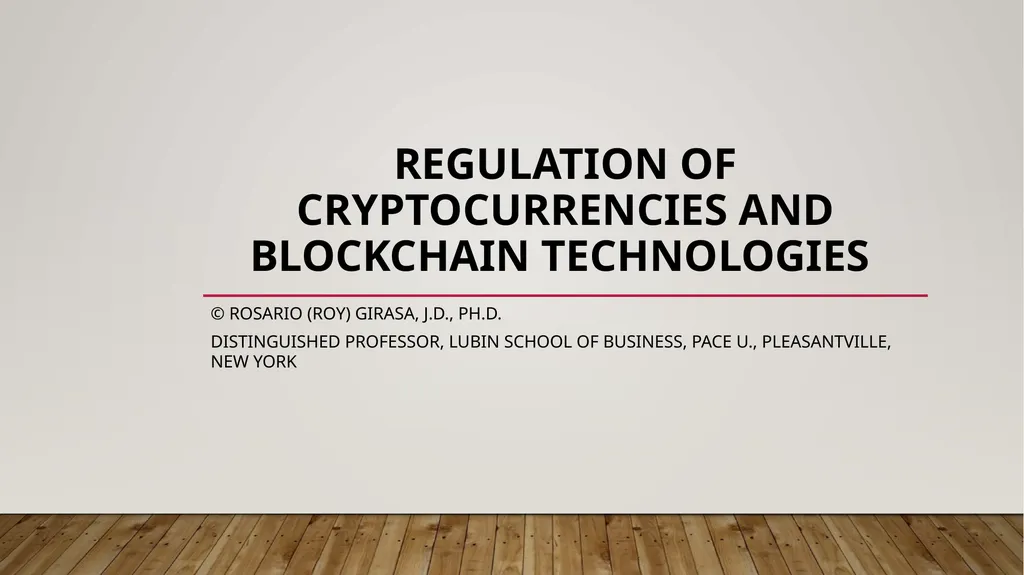REGULATION OF CRYPTOCURRENCIES AND BLOCKCHAIN
Author : danika-pritchard | Published Date : 2025-05-24
Description: REGULATION OF CRYPTOCURRENCIES AND BLOCKCHAIN TECHNOLOGIES Rosario Roy Girasa JD PhD Distinguished Professor Lubin School of Business Pace U Pleasantville New York CHAPTER ONE THE DIGITAL TRANSFORMATION BASICS The digital
Presentation Embed Code
Download Presentation
Download
Presentation The PPT/PDF document
"REGULATION OF CRYPTOCURRENCIES AND BLOCKCHAIN" is the property of its rightful owner.
Permission is granted to download and print the materials on this website for personal, non-commercial use only,
and to display it on your personal computer provided you do not modify the materials and that you retain all
copyright notices contained in the materials. By downloading content from our website, you accept the terms of
this agreement.
Transcript:REGULATION OF CRYPTOCURRENCIES AND BLOCKCHAIN:
REGULATION OF CRYPTOCURRENCIES AND BLOCKCHAIN TECHNOLOGIES © Rosario (Roy) Girasa, J.D., Ph.D. Distinguished Professor, Lubin School of Business, Pace U., Pleasantville, New York CHAPTER ONE THE DIGITAL TRANSFORMATION BASICS The digital transformation New business models due to internet Rise almost overnight of multi-billion dollar companies What is money? Historical evolution as substitute for barter Barter in modern times Trust as basis – Reserve Bank of Zimbabwe banknote IMF - SDRs 2 REASONS FOR RISE OF VIRTUAL CURRENCIES Costs of third-party servicing and modernization of payments Lack of security Lack of convertibility or unavailability in 3d world Anonymity or Pseudonymity Universality of cryptocurrencies Profit motivation Trust factor 3 TYPES OF CURRENCIES Fiat currencies Digital currencies Virtual currencies Convertible Centralized Decentralized Non-convertible Cryptocurrencies as subset of virtual currencies 4 KEY ACTORS IN DIGITAL TECHNOLOGY Inventors Issuers or administrators Miners Process service providers Users or customers Wallet provider Exchanges 5 BENEFITS AND RISKS OF VIRTUAL CURRENCIES Benefits of virtual currencies: Verification of identity Significant reduction in costs Speed of money transfers Facilitation of micro-payments Reduction of exposure risks Use by persons unable to use banking facilities Recording of transactions such as deeds 6 BENEFITS AND RISKS OF VIRTUAL CURRENCIES (CONT.) Risks of virtual currencies: Lack of acceptance by banks and protections afforded by them Loss of interest on deposits Security concerns – use by criminal elements and tax evaders Volatility Payment beneficiary identification Limited user base Uncertainty of future regulation Cyberthreats by hacking, theft, loss of private key 7 BENEFITS AND RISKS OF VIRTUAL CURRENCIES (Cont.) Governmental agencies risks assessment Operational risks – lack of government supervision Cybersecurity risks – commingling of customer assets and vulnerability of platforms Speculative risks – volatility and price swings Fraud and manipulation risks Bitcoin kiosks lack of safeguards and high fees Failure to register currency transactions as securities Tax considerations and how to treat cryptocurrencies as property or currencies 8 CHAPTER TWO TECHNOLOGY UNDERLYING CRYPTOCURRENCIES AND TYPES Blockchain technology – underlies cryptocurrencies and is an electronic distributed ledger technology Combination of components including peer-to-peer networking, distributed data storage, and cryptography It is a type of database shared across nodes in a network It is decentralized, adding changes to the database in the form of completed blocks of transactional data connected to each other in a chain in which transaction data is stored in a chronological order 9 UNDERLYING TECHNOLOGY of blockchain (Cont.) Users of the block receive














